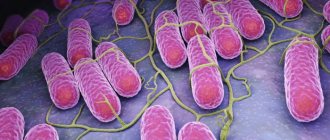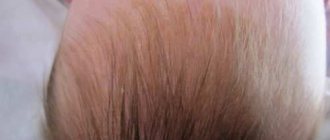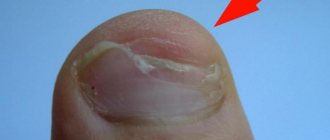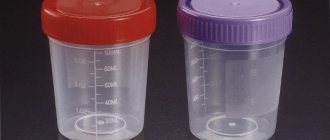What should a normal stool look like?
At different stages of development, the baby's stool changes from a liquid, unnatural color to a fraction characteristic of each person. Parents must be sure to monitor the frequency, consistency, color and presence of odor in the child’s discharge.
First three days of life
During this period of a little person’s life, the accumulation of remnants of amniotic fluid that entered the body at birth, intestinal epithelial cells, bile, mucus, etc. occurs in his intestines. Such feces are called original feces or meconium.
The discharge has a black, dark red or olive tone, a resinous structure and is odorless. Green stool in a newborn is not due to the bacterial nature of its formation. The appearance of discharge is the first sign of normal functioning of the gastrointestinal tract.
During the first two to three days, a breastfed baby’s body completely absorbs the mother’s colostrum, so feces are not formed.
Fourth – sixth days
The baby's intestinal system is developing due to changes in the composition of the nursing mother's milk and the formation of bacteria in the digestive tract.
The process occurs in two stages:
- Transitional feces
The baby's stool has the appearance of a paste, thick sour cream, the color is predominantly yellowish, with rare splashes of green (residual effects of meconium). The presence of a white mass and small amounts of stool with mucus in an infant is not a deviation. Changes in the appearance of feces occur under the influence of bacteria in the gastrointestinal tract.
- Mature feces
The discharge takes on a dark green color with a transitional gray tint, and has a porridge-like consistency. Initially, the frequency of bowel movements is about ten times a day, and as you get used to breast milk, the frequency of bowel movements decreases to one or two times over three to seven days.
This is due to the complete absorption of the beneficial substances of breast milk in the infant’s gastrointestinal tract. It is necessary to strictly monitor meconium in the stool: if its presence in the stool is observed on the fifth day, you should consult a doctor. Artificial feeding can affect the structure of stool.
Second week of life – 28 days
The baby's stool takes on a light brown, mustard color. The consistency of the mass is mushy. Green, liquid stool in a baby or constipation indicate the occurrence of abnormalities.
First months
At the stage of feeding the baby with breast milk, the stool is normally mature. The waste products of a baby can be light brown, grayish and even green. The feces of a month-old baby on breastfeeding should be of medium density: neither liquid nor solid.
At 3 years of age, the presence of food inclusions in the stool is allowed, and the color directly depends on the food the child eats.
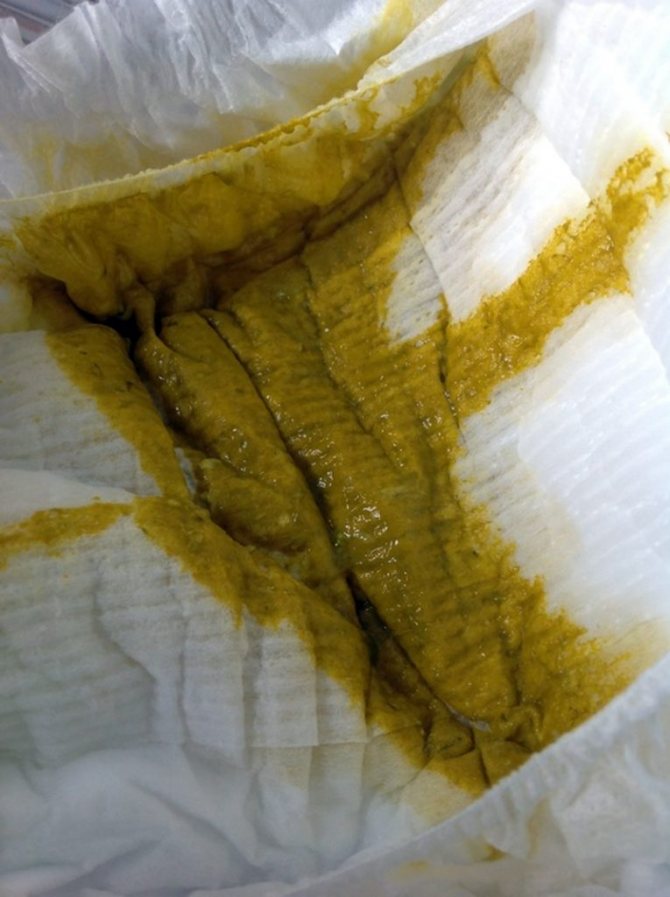
Is green stool normal?
Green stool in a formula-fed baby is not considered a pathology if the child does not suffer from it. When his behavior and well-being do not change, there is no need to panic. What should alert you is that the baby is not the same as usual. An attentive mother will immediately notice changes in the baby’s behavior; perhaps he has become less active or more capricious, cries more often and presses his legs to his stomach.
Note! If green stool persists for a long time, this may be a sign that the formula needs to be changed. It is necessary to discontinue the mixture and introduce a new one gradually.
A similar color appears with the beginning of complementary feeding, when green vegetables, such as zucchini or broccoli, are introduced. This is how the body reacts to new foods. In this case, everything will quickly return to normal and the green tint will disappear.
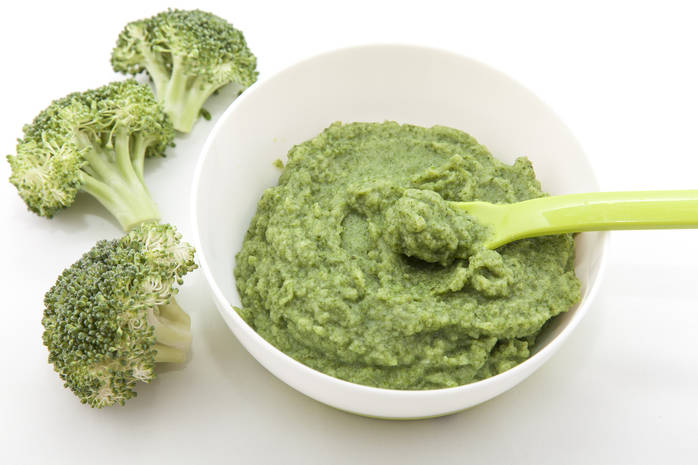
Dish that changes stool color
If your baby is taking any medications, you should make sure that there are no side effects of such a symptom. Then stop giving the medications and replace them with others. This should be done after a conversation with the pediatrician. After examination, the doctor will select the appropriate medicine.
We must remember! The stool of formula-fed babies cannot be compared with the stool of breastfed children. It differs in consistency, smell and color.
If the condition is alarming and different from usual, you should consult a doctor. He will determine whether this is normal or considered a pathology. If necessary, the pediatrician will prescribe additional examinations and tests.
Causes of green stool in infants
Green stool in a baby is not always a cause for concern. Let us highlight the main factors that can cause “herbal” feces to appear in an infant in the first months of his life.
Causes of green stool
Sources of unnatural stool color in a baby:
- composition of mother's breast milk;
- use of complementary foods;
- deviation of the baby’s immunity;
- age-related changes.
When breastfeeding
The reasons for the appearance of greenish stool in a child during breastfeeding can be:
- mother’s food range: if the diet is rich in green vegetables and herbs;
- intoxication of the nurse's body due to poisoning;
- exposure to medications: for example, taking antibacterial agents;
- lack of nutrition: limited amount of breast milk, early refusal of breastfeeding. The feces become liquid and foamy, and the baby’s weight drops.
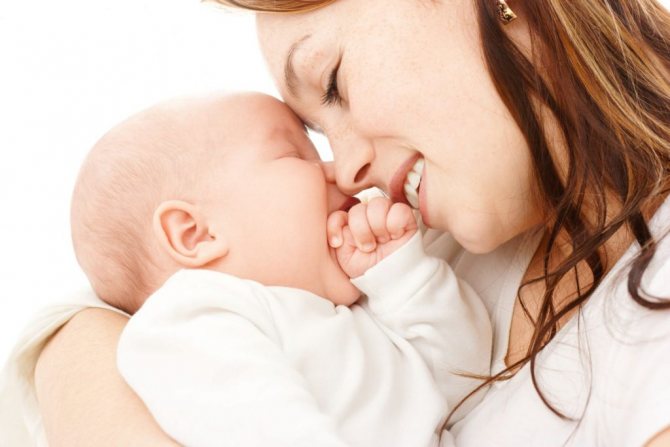
With artificial and mixed feeding
A green tint to the stool of a mixed-fed baby occurs depending on the composition of complementary foods:
- artificial mixture is enriched with iron;
- food causes an imbalance in the child’s body, allergic reactions occur;
- incorrectly selected or incorrectly prepared food;
- dysbacteriosis, immune system failure: complex components of complementary foods complicate the functioning of the gastrointestinal tract.
General sources
The basic factors for the manifestation of green stool in infants are:
- chemical oxidation processes under the influence of oxygen;
- inflammatory foci in the infant’s gastrointestinal tract due to difficult childbirth;
- natural removal of bilirubin (bile pigment) from the body;
- additional nutrition with a mixture with a high concentration of sugars and iron;
- lactose intolerance, bacterial imbalance;
- the impact of diseases, poor functioning of the endocrine system, malfunction of the gastrointestinal tract.
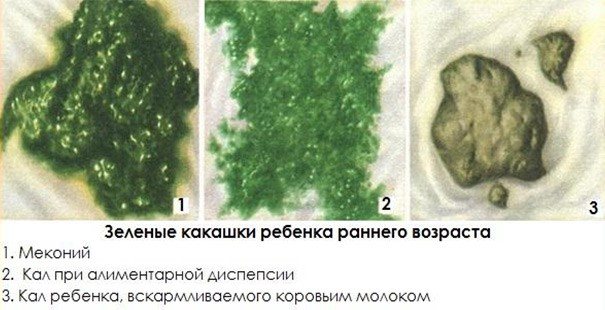
Dysbacteriosis
When the balance of vital bacteria is disturbed, the natural functioning of the intestines is disrupted in the baby’s body. The condition is characterized by an increase in body temperature, disruption of the process of excretion of feces, and psycho-emotional disorders.
If the course of the disease is favorable, the baby’s immunity copes with it on its own. If the disorder lasts, you will need to take foods enriched with bacteria.
Lactase deficiency
The condition is expressed by difficulty in processing milk sugar due to a small amount of lactase and, as a consequence, the development of dysbacteriosis. The stool is liquid, greenish-yellow with a pungent odor and foamy consistency.
The deviation goes away on its own after nine months of the baby’s life, less often up to a year. Sometimes there is a hereditary disorder. To restore the baby’s stool, it is recommended to adjust the diet of the mother producing breastfeeding, as well as the use of therapy to replenish lactase in a child at 2 years old.
By month
The stages of development of the baby’s body directly affect the appearance of green color in the stool:
- 1 month: green stool in a newborn is the norm, a consequence of the gastrointestinal tract adapting to nutrition, if the process is not accompanied by third-party symptoms;
- 2 month: dysbacteriosis is possible due to the unstable state of the intestines of a two-month-old baby;
- 3 month: due to slow development, green stool in a 3 month old baby may be an indicator of normality;
- 4 months: a common cause of green stool is untimely complementary feeding;
- 5th month: the color of the stool in a five-month-old baby depends on the administration of additional nutrition;
- 6-7 months: the baby eliminates discomfort from emerging teeth by biting foreign objects, so green stool in the child will become an indicator of disorder or infection;
- 8-10 months: bilirubin no longer affects the color of stool, discharge depends on the composition of complementary foods;
- 11-12 months: Green stool in a 1 year old baby is an indicator of food intake or an allergic reaction.
Green stool as one of the symptoms of the disease
Parents should take immediate action if their child's green stool is accompanied by the following symptoms:
- decreased mobility, drowsiness, moodiness;
- loss of appetite;
- foamy consistency of stool in infants,
- a sharp putrid odor of feces in a one-year-old child, green foam bowel movements;
- Green, liquid stool is passed out very often in infants;
- entry of blood as a cause of gastrointestinal damage;
- incessant diarrhea in a one and a half year old child;
- vomiting, frequent regurgitation of food;
- the child has green, loose stools with large quantities of mucus;
- flatulence, colic;
- skin rashes.
What determines the change in stool color?
Green stool in an infant may indicate illness, but not always.
The reasons for the color change may be as follows.
- In a newborn, bilirubin may be excreted in the stool, which gives it a green color.
- The child's body is influenced by the mother's hormones.
- The newborn’s digestive system is not fully formed, which sometimes results in a lack of enzymes for breaking down food. In this case, the stool may contain mucus.
- If you do not change the diaper on time, the feces can oxidize under the influence of oxygen and acquire shades of green.
- When breastfeeding, the mother's nutrition plays a role. Perhaps she ate foods that could affect the color of stool - pear, cabbage, cucumber, zucchini.
- Taking medications containing iron.
- There is not enough breast milk, resulting in the baby not receiving enough enzymes that help break down milk sugars and fats.
- Lack of lactose in milk.
If there are streaks of blood in your child's stool, you should seek help from a specialist. In addition, there may be liquid stool with mucus and a strong odor. In this case, the reasons are much more serious.
- Dysbacteriosis. The child is bothered by bloating, colic, and skin rashes may appear. In breastfed children, disruption of intestinal flora can occur even if the mother additionally drinks boiled water. Loose stools appear, often with mucus.
- Bacterial infections.
- Diseases caused by a virus that affects the proper functioning of the intestines, and stool changes its color to green.
- Intestinal infections: fever, vomiting, abdominal pain.
- After taking antibiotics. The stool becomes green in color. May be slimy in nature.
- Allergies are a common cause.
- Pathologies of the digestive organs. This type of violation requires surgical intervention.
- Colonization of the body by parasites (helminths, worms).
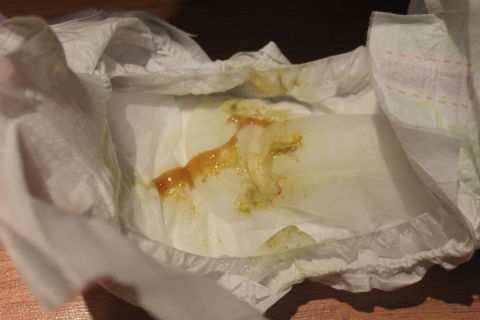
What does the shade and consistency of green stool tell us?
Based on the degree of color saturation and density of green feces, one can judge the reasons for the changes:
- deep green: normal; depends on the food range; dark green, loose stools in infants may be a consequence of lactase deficiency;
- light green, yellow-green: normal indicator; impaired lactation or lack of breast milk with hind fat milk;
- black-green: typical only for newborns, in other cases it is a malfunction of the gastrointestinal tract, a nutritional error;
- deep green: lack of hindmilk, food pigmentation;
- green foam: lactase deficiency, low fat content of milk during breastfeeding;
- mushy: normal indicator;
- green stool with mucus, watery, liquid, too hard stool: deviation of the gastrointestinal tract, development of the disease.
The reason for panic among parents should be the general deterioration of the baby’s condition.
What to do if you have green stools?
If your stool appears green, the following actions are recommended:
- Ensure that the baby is properly attached to the breast, allow him to get enough and complete breastfeeding on his own.
- Make breastfeeding regular, depending on the body's needs.
- Control your diet during breastfeeding, avoid artificial additives and exotic foods.
- Treat the baby's intestinal dysfunction under the supervision of a doctor.
- Don't worry if your stools turn green after taking Smecta.
- Thoroughly study the composition of artificial complementary foods, ensure optimal selection for the baby’s body (for example, use NAN mixtures).
- Green stools without accompanying warning signs are normal and do not require intervention.
- Use of additional nutrition in due time.
- Dr. Komarovsky can give an online consultation on his website.
- The frequency of green stools in combination with alarming symptoms is a necessity for seeking medical help.
Green stool in a newborn during breastfeeding is not always a deviation. If your child is developing normally, cheerful and active, there is no need to worry once again about why the child has green stool and tirelessly torment the child with visits to the doctor.
Control your diet during breastfeeding, provide your children with proper care, monitor their behavior, and then there will be much less cause for alarm.
Green stool while breastfeeding
A breastfed baby's stool often has a runny consistency with white lumps of curdled, undigested milk. If previously it was light brown in color, then there may be several reasons for the appearance of greenery.
- Dysbacteriosis. This is the most common cause of green stool in a newborn. Since the microflora of the baby’s digestive system is at the stage of formation, it happens that instead of beneficial microbes, pathogenic or conditionally pathogenic microflora begin to multiply in it, which causes dysbiosis and difficulties with digesting food, which results in the baby’s green stool. As soon as the balance of microorganisms returns to normal, the baby’s green stool will also disappear.
- Imbalance of foremilk and hindmilk. It occurs due to the baby’s lack of fat-rich hindmilk due to rapid fatigue from sucking or the mother’s limited time at the breast.
- The child’s body does not yet produce enough digestive enzymes and green stool indicates difficulty digesting nutrients.
- Oxidation reaction of feces components in air.
- Taking certain medications. This is especially true for antibiotics that can disrupt the natural intestinal microflora.
- Infants may excrete bilirubin along with their feces, traces of which disappear in the feces by three to four months of age.
- Features of the child's mother's diet. So, if a mother eats a lot of green fruits and vegetables, then it is quite possible that some of the coloring substances can penetrate into the mother’s milk, then into the baby’s body and turn his stool green.



